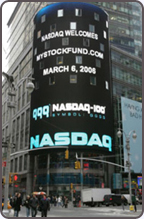|
The Power of Compounding and Dollar Cost Averaging
You can benefit from the dollar cost averaging investing strategy and the power
of compounding earnings. Here’s how (and here’s why it works)!
Dollar cost averaging
You can use your MSFS dollar based purchase plans for dollar cost investing
programs.
Many have spent untold hours to reduce the art and science of investing to a
formula. One of the more enduring and successful programs is dollar cost
averaging. Some commentators have called dollar cost averaging the unbeatable
formula.
Dollar cost averaging is one of the simplest investment strategies, investing a
constant amount of money in common stocks over a long period, regardless of the
level of stock prices. This steady accumulation of stocks proceeds at regular
intervals. The same dollar amount purchases fewer shares when prices are high,
more shares when prices are low. Price fluctuations are beneficial as a price
decline provides an opportunity to buy additional shares at a low price.
A simple example illustrates the idea. If you invest $1200 in shares of a given
company in each of three years buying 20 shares at $60 in the first year, 40
shares at $30 in the second year, and 24 shares at $50 in the third year.
| Year |
Price |
Shares |
| 1 |
$60.00 |
20 |
| 2 |
$30.00 |
40 |
| 3 |
$50.00 |
24 |
| |
|
84 |
You will have 84 shares at $50 with a value of $4200 at the time of your third
year purchase, a gain of $600 even though the price of the security has
fluctuated.
Dollar cost averaging programs helps you avoid emotional purchases and sales,
buying shares when the market is too high and liquidating shares when the
market is too low. Stocks whose prices fluctuate generate better profits than
those that do not fluctuate. Price fluctuations are your friend in dollar cost
averaging programs.
Dollar cost averaging is a long term investment program of at least five years
with two requirements, a long term view, and a steady flow of funds for
investment. The beginning time is not important.
The portfolio you select must be managed to eliminate undesirable issues when
necessary. Our economy changes and some companies are unable to maintain their
markets share as technologies change.
You can decrease your risk by diversifying your portfolio or by purchasing
stocks that have lower fluctuations, less volatility. You can dampen the
volatility of your portfolio by maintaining some portion in cash of short term
investments. You can increase your risk, and maybe increase your rate of return
with a one or a few stock portfolio, or a portfolio with stocks in one market
segment.
The few disadvantages of a dollar cost averaging program include gaming the
program by attempting to time the market, delaying purchases in declining
markets or when the market appears high, or by diverting funds to other uses.
The ending time is important. You should not end your program during an extended
market decline.
Dollar cost averaging does not answer all investment needs. It does not work for
in and out trading or for the investment of lump sums.
Summary
Dollar cost averaging is the disciplined process of investing a fixed amount of
money into a particular security over a period of fixed investment dates. Sound
familiar? It is similar to your investing in your company’s 401K Plan. An
example of such investing practices can be demonstrated by investing $500 in
the McDonald’s (MCD) on the first Thursday of every month through your
MyStockFund account. Since your dollar amount is fixed, if MCD is trading
higher that day, you will be buying fewer shares. If it is trading lower, you
will be buying more shares at a lower price. This practice, over time, allows
you to benefit from stock markets price fluctuations while reducing your
emotional decisions.
Compound earnings
You can use your MSFS purchase plans to compound your asset’s earnings with your
dividends.
Compound earnings is earnings on earnings. The rate of return earned in a year
is earned on the value of the asset at the end of the previous year. The rate
of return or earnings can be interest on fixed income securities, dividends or
growth in the market value of securities. We are going to assume an 8% rate of
return for our example.
If you invest $100 and earn 8% during the first year you begin the second year
with assets of $108.00. Your earnings at 8% during the second year are $8.64.
The extra sixty four cents are the 8% earnings on the $8.00 you earned in the
first year. Your earnings include earnings on your prior earnings, or earnings
on earnings.
The following table illustrates the effect of reinvesting all earnings for ten
years.
| Year |
Earnings |
Asset Value, end of year |
| 1 |
8.00 |
108.00 |
| 2 |
8.64 |
116.64 |
| 3 |
9.34 |
125.98 |
| 4 |
10.08 |
136.06 |
| 5 |
10.89 |
146.95 |
| 6 |
11.76 |
158.71 |
| 7 |
12.70 |
171.41 |
| 8 |
13.72 |
185.13 |
| 9 |
14.81 |
199.94 |
Our assets have almost doubled from $100 to $199.94 in 9 years by compounding
our earnings.
Assets that compound, or earn on their prior earnings, double more quickly that
assets that do not compound. An asset that earns 8% a year but is unable to
earn on the earned assets will double in 12.5 years. An asset that earns 8% and
is able to compound by earning on the prior earnings will double in 9 years.
The double occurs 3.5 years quicker.
We sometimes use the rule of 72 to estimate the number of years necessary to
double an asset with compound earnings. Assets that compound their rate of
return, earning on the prior earnings, double with compound earnings in the
number of years that result from dividing 72 by the rate of return. An asset
that compounds with an 8% rate of return doubles in 9 years. 72/8 = 9 years.
Using the rule of 72, if the rate of return is 6%, compounding assets double in
12 years. 72/6 = 12 years. Alternatively, if the rate of return is 9%,
compounding assets double in 8 years. 72/9 = 8 years.
Your can enhance the compounding of your portfolio assets by reinvesting your
dividends, the compounding of earnings.
Summary
You may choose to direct MSFS to automatically reinvest your dividends that you
receive on your portfolio securities into more shares of the company stock. You
can elect to have your MCD dividends purchase more shares of MCD at the then
prevailing market price of MCD. This compounding effect helps you build a
portfolio - one day at a time.
Conclusion
Your MyStockFund account with its dollar based plan facilitates your dollar cost
averaging program, and the automatic dividend reinvestment puts your dividend
to work to compound your earnings.
You too, can now benefit from this investing strategy and compound earnings.
|







